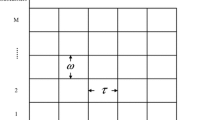Abstract
Recently, the interest of the telecommunication operators and Internet service providers (ISPs) in energy efficiency (EE) for wireless networks has remarkably increased. The boost in energy prices, the continuous increase of the user numbers, the pervasion of wideband access, and the diffusion of offered services have motivated this interest. The challenge is to minimize the transmitted energy without compromising the quality of service (QoS) and the network performance. In this paper, a new efficient Orthogonal Frequency Division Multiple Access (OFDMA) resource allocation for Long Term Evolution (LTE)-advanced systems based on cross-layer optimization between Physical (PHY) and Medium Access Control (MAC) layers is proposed. A new solution based on Rate Adaptive (RA) principle is presented to achieve better EE resource allocation. The purpose behind the new model is to increase the capacity of the system as much as possible while trying to decrease the total transmit power. Hence, the EE which is equal to the capacity to total transmit power ratio is increased. As reducing the transmit power for the transmission of a given capacity reduces the power consumption, the greenhouse gas (GHG) emission will be then reduced. On the other hand, the service differentiation is highly considered to provide high QoS support. The users are differentiated according to different service classes and different data rates. The proposed cross-layer-based solution has then to allocate the system resources in an optimal way while satisfying the users having high QoS requirements.













Similar content being viewed by others
References
Feng D, Jiang C, Lim G, Cimini LJ, Feng G, Li GY (2013) A survey of energy-efficient wireless communications. IEEE Commun Surv Tutor 15(1):167–178
Singh R (2008) Wireless technology: to connect the unconnected. World Bank: 10–20
Amanna A, Reed J, Bose T, Newman T (2009) Metrics and measurement technologies for green communications. National Institute of Standards and Technology, Technology Innovation Program: 50–66
3GPP TSG-RAN-1, R1-030999: considerations on the system performance evaluation of HSDP using OFDM modulations, RANWG1 #34: 1–20
Lamour C (2008) Energy consumption of mobile networks. The Basestation e-Newsletter: 1–5
Bianzino AP, Chaudet C, Rossi D, Rougier J-L (2012) A survey of green networking research. IEEE Commun Surv Tutor 14(1):3–20
Han C, Harrold T, Armour S, Krikidis I, Videv S, Grant P, Haas H, Thompson J, Ku I, Wang CX, le T, Nakhai M, Zhang J, Hanzo L (2011) Green radio: radio techniques to enable energy-efficient wireless networks. IEEE Commun Mag 49(6):46–54
Wu J (2012) Green wireless communications: from concept to reality. IEEE Wirel Commun 19(4):4–5
Holma H, Toskala A (2010) WCDMA for UMTS: HSPA evolution and LTE. Wiley: 100–150
Wang H (2008) Priority-based resource allocation for RT and NRT traffics in OFDMA Systems. International Journal of Communications, Network and System Sciences (IJCNS), (3) pp 791–794
Cheng P, Yu G, Zhang Z, Qiu P (2014) Fair adaptive resource allocation algorithm for heterogeneous users in OFDMA system. IEEE Int Conf Commun Circ Syst (5):402–406
Yu G, Zhang Z, Chen Y, Qiu P (2006) A novel resource allocation algorithm for real-time services in multiuser OFDM systems. IEEE Vehicular Technology Conference (VTC), (63) pp 1156–1160
Vakilina S, Khouzani HK, Khalaj B (2012) Energy efficient QoS-aware resource allocation in OFDMA systems. IEEE Canadian Conference on Electrical & Computer Engineering (CCECE), (25) pp 1–6
Anas M, Kim K, Shin S, Kim K (2004) QoS aware power allocation for combined guaranteed performance and best effort users in OFDMA systems. IEEE Intell Signal Process Commun Syst (9):477–481
Xiao X, Tao X, Lu J (2015) Energy-efficient resource allocation in LTE-based MIMO-OFDMA systems with user rate constraints. IEEE Trans Veh Technol 64(1):185–197
Gotsis G, Komnakos D, Constantinou P (2009) Linear modeling and performance evaluation of resource allocation and user scheduling for LTE-like OFDMA networks. IEEE Int Symp Wirel Commun Syst (7):196–200
Kaddour FZ, Vivier E, Mroueh L, Pischella M, Martins P (2015) Green opportunistic and efficient resource block allocation algorithm for LTE uplink networks. IEEE Trans Veh Technol 64(10):4537–4550
Kalil M, Shami A, Al-Dweik A (2015) QoS-aware power-efficient scheduler for LTE uplink. IEEE Trans Mob Comput 14(8):1672–1685
Matalgah MM, Paudel B, Hammouri OM (2013) Cross-layer resource allocation approach in OFDMA systems with multi-class QoS services and users queue status. IEEE Global Communications Conference (GLOBECOM), pp 1385–1390
Chen J-J, Luo C-W, Chen Z-Y (2016) A novel energy-saving resource allocation scheme in LTE-A relay networks. Green Commun Mobile Wirel Netw:1–14
Liu B, Tian H, Xu L (2013) An efficient downlink packet scheduling algorithm for real time traffics in LTE systems. IEEE Consumer Communications and Networking Conference (CCNC), (10) pp 364–369
Molisch AF (2011) 3GPP Long Term Evolution. IEEE Wirel Commun:665–698
Furqan F, Hoang DB, Collings IB (2014) Effects of quality of service schemes on the capacity and dimensioning of LTE networks. IEEE International Performance Computing and Communications Conference (IPCCC), (33) pp 1–8
Bertsekas DP (2009) Convex optimization theory. Athena Sci: 1-30
Lagrange JL (1965) Mecanique Analitique, Complete edn. Albert Blanchard, Paris
Khalil A, Crussiere M, Helard J-F (2009) Resource allocation scheme for multi-band high rate UWB systems. IEEE International Conference on Communications and Mobile Computing (ICCMC), (20) pp 314–319
Author information
Authors and Affiliations
Corresponding author
Additional information
Publisher’s note
Springer Nature remains neutral with regard to jurisdictional claims in published maps and institutional affiliations.
Rights and permissions
About this article
Cite this article
Khalil, A., Hélard, JF. Energy-efficient cross-layer resource allocation scheme for OFDMA systems. Ann. Telecommun. 76, 399–411 (2021). https://doi.org/10.1007/s12243-020-00825-9
Received:
Accepted:
Published:
Issue Date:
DOI: https://doi.org/10.1007/s12243-020-00825-9




